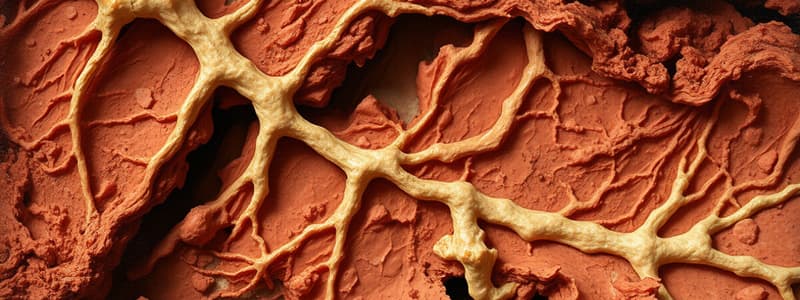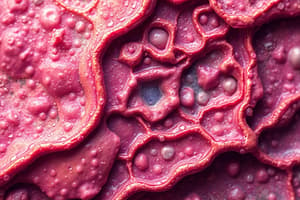Podcast
Questions and Answers
What is the function of connective tissue?
What is the function of connective tissue?
- Pumps blood
- Anchors, packages and supports body organs (correct)
- Lines body cavities
- Transmits electrochemical impulses
Which type of tissue lines body cavities?
Which type of tissue lines body cavities?
- Epithelium (correct)
- Muscle
- Connective Tissue
- Nervous Tissue
What major function does muscle tissue perform?
What major function does muscle tissue perform?
Contracts
What type of tissue transmits electrochemical impulses?
What type of tissue transmits electrochemical impulses?
Where can simple columnar epithelium be found?
Where can simple columnar epithelium be found?
What is hyaline cartilage primarily composed of?
What is hyaline cartilage primarily composed of?
Which tissue type acts as a storage depot for fat?
Which tissue type acts as a storage depot for fat?
What does hematopoietic tissue replenish?
What does hematopoietic tissue replenish?
Where is fibrocartilage primarily found?
Where is fibrocartilage primarily found?
What type of epithelium is found lining the trachea?
What type of epithelium is found lining the trachea?
What is the primary function of stratified squamous epithelium?
What is the primary function of stratified squamous epithelium?
Study Notes
Classification of Tissues
-
Connective Tissue
- Anchors and supports body organs
- Most durable tissue type
- Characterized by abundant nonliving extracellular matrix
- Most widespread tissue in the body
-
Epithelium
- Lines body cavities, covers external surfaces
- Functional roles include absorption, secretion, and filtration
- Capable of synthesizing hormones
-
Muscle Tissue
- Responsible for pumping blood and flushing urine
- Enables voluntary movements, e.g. swinging a bat
- Major function is contraction
-
Nervous Tissue
- Transmits electrochemical impulses
- Primarily involved in regulating and controlling body functions
- Forms the brain and nerves
Types of Epithelium
-
Simple Columnar Epithelium
- Non-ciliated type lines digestive tract, gallbladder, and excretory ducts
- Ciliated variety found in small bronchi and uterine tubes
-
Simple Cuboidal Epithelium
- Located in kidney tubules, small glands, and ovary surface
-
Simple Squamous Epithelium
- Found in kidney glomeruli and air sacs of lungs
- Also lines the heart, blood vessels, lymphatic vessels, and ventral body cavity
-
Pseudostratified Columnar Epithelium
- Non-ciliated type present in male reproductive ducts
- Ciliated variety lines the trachea and upper respiratory tract
-
Stratified Squamous Epithelium
- Non-keratinized version lines moist surfaces like the esophagus and vagina
- Keratinized variety forms the epidermis of skin
-
Stratified Cuboidal Epithelium
- Seen in largest ducts of sweat glands and mammary glands
-
Stratified Columnar Epithelium
- Rare, present in small quantities in male urethra and large glands
-
Transitional Epithelium
- Lines the ureters, bladder, and part of urethra
Types of Connective Tissue
-
Adipose Connective Tissue
- Functions as a fat storage depot
- Provides insulation against heat loss
-
Areolar Connective Tissue
- Composes basement membranes
- Acts as soft packaging tissue with a jellylike matrix
-
Dense Fibrous Connective Tissue
- Attaches muscles to bones and bones to bones
- Found in the dermis of the skin
-
Elastic Cartilage
- Provides flexible structure for the external ear
-
Fibrocartilage
- Forms intervertebral discs
-
Hematopoietic Tissue
- Responsible for replenishing red blood cells
-
Hyaline Cartilage
- Forms structures like larynx and costal cartilages
- Characterized by a glassy, smooth matrix
-
Osseous Tissue
- Makes up the hip bone
- Matrix is hard due to calcium salts, providing levers for muscular action
Studying That Suits You
Use AI to generate personalized quizzes and flashcards to suit your learning preferences.
Description
Test your knowledge on the types of tissues in the body with these flashcards from Chapter 6A. Each card contains key definitions and functions of connective tissue, epithelium, and muscle. Perfect for reinforcing your understanding of histology and anatomy.




